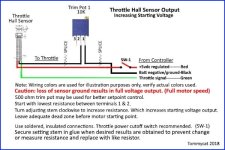Hello,
I'm all new to this so bear with me silly questions or lack of knowledge of the RC world.
I've been building a stand-up e-scooter from an Oxelo scooter and have managed somehow to assemble all the parts together. To handle the speed I used the servo tester coupled to a thumb throttle. I use the following topic as a guide:
https://endless-sphere.com/forums/viewtopic.php?f=28&t=12196&start=175#p1278793
I did the same wiring but when I tried to use it with the ESC it doesn't work, or I don't know how to do it properly maybe. The ESC is this one:
https://hobbyking.com/fr_fr/turnigy-brushless-esc-85a-w-5a-sbec.html
The manual can be found here:
https://cdn-global-hk.hobbyking.com/media/file/t/u/turnigy_85a_esc.pdf
So I thought I only had to calibrate it to make it work (page 8 ), but I don't get the beep I'm supposed to get. Here's what did:
- Push the thumb thottle to the max
- Plug the battery to the ESC
- Wait for 2 beeps (which does sound)
- Release the thumb throttle completely
--> Now I'm supposed to hear some beep to confirm the calibration has been done, but this where nothing happens.
If I hold the thumb throttle to the max for long, I hear all kind of funny beeps that are not even described in the manual.
I should point out that when I push the throttle to the max, the blue led on the servo is shown.
Would anybody know what's going on? Did I mess up with the servo wiring?
I can provide photos/videos if necessary.
Thanks
I'm all new to this so bear with me silly questions or lack of knowledge of the RC world.
I've been building a stand-up e-scooter from an Oxelo scooter and have managed somehow to assemble all the parts together. To handle the speed I used the servo tester coupled to a thumb throttle. I use the following topic as a guide:
https://endless-sphere.com/forums/viewtopic.php?f=28&t=12196&start=175#p1278793
I did the same wiring but when I tried to use it with the ESC it doesn't work, or I don't know how to do it properly maybe. The ESC is this one:
https://hobbyking.com/fr_fr/turnigy-brushless-esc-85a-w-5a-sbec.html
The manual can be found here:
https://cdn-global-hk.hobbyking.com/media/file/t/u/turnigy_85a_esc.pdf
So I thought I only had to calibrate it to make it work (page 8 ), but I don't get the beep I'm supposed to get. Here's what did:
- Push the thumb thottle to the max
- Plug the battery to the ESC
- Wait for 2 beeps (which does sound)
- Release the thumb throttle completely
--> Now I'm supposed to hear some beep to confirm the calibration has been done, but this where nothing happens.
If I hold the thumb throttle to the max for long, I hear all kind of funny beeps that are not even described in the manual.
I should point out that when I push the throttle to the max, the blue led on the servo is shown.
Would anybody know what's going on? Did I mess up with the servo wiring?
I can provide photos/videos if necessary.
Thanks


